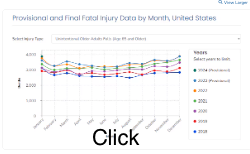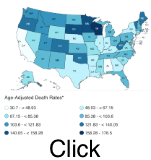


| Fall Injuries by State |  |
| Falls Deaths by Month |  |
| Fall Deaths by State |  |
Community falls
Falls are a significant health risk in homes, communities and healthcare facilities.
The CDC consistently reports that falls are the leading cause of injuries of older adults.
The fall injury rate and fall mortality rate varies across states and by season.
The winter months have the largest number of falls.
You can visit the Older Adult Fall Prevention CDC site for more falls data
According to Choi et al. (2019) approximately one-third of older adults who received medical attention for fall injuries had an ED visit alone. Less than a fifth had an overnight hospital stay. The data was obtained from the 2013–2017 US National Health Interview Survey files of 1840 patients over 60 years of age. Patients with lung disease and memory issues were associated with just an ED visit while patients with hip and head injuries, facial injuries and other bone fractures were likely to stay longer in a hospital
Healthcare Associated Conditions
Falls and their associated injuries are among the 14 categories of Hospital acquired conditions for which hospitals will not receive additional Centers Centers for Medicare & Medicaid Services payment for cases where the conditions were not present on admission.
Fall prevention goals
Preventing patient falls is a Health and Human Services, Agency for Healthcare Research Quality - Patient Safety Network, top ten patient safety concern for 2024.
The Joint Commission has selected fall prevention as a 2024 National Patient Safety Goal for assisted living communities, home care, and nursing care centers. Visit the The Joint Commission - National Patient Safety Goals website, https://www.jointcommission.org/standards/national-patient-safety-goals/
Inpatient falls
According to Dykes et al (2024) falls are a significant risk particularly within healthcare settings. A patient fall is defined most often as an unplanned descent to the floor with or without injury to the patient.
A fall may be categorized as:
Nursing home resident falls
According to Agency for Health Research Quality (AHRQ), approximately 50% of nursing home residents fall every year. It is estimated that 1 in 3 of those who fall will fall two or more times in a year. One in every 10 residents who fall will experience a related severe injury. About 65,00 patients suffer hip fractures in a year. Of those falls, 1,800 nursing home residents result in deaths. https://www.ahrq.gov/patient-safety/settings/long-term-care/resource/injuries/fallspx/man1.html.Hospital Falls
According to LeLaurin et al (2019) patient falls are common preventable adverse events within hospitals, yet 700,000 to 1 million patients fall in hospitals in the U. S. every year.In the United States, estimated hospital fall rates vary from 3.3 to 11.5 falls per 1000 patient days with approximately 25% of hospital falls resulting in injury. Those injuries increase a patient’s length of stay, healthcare costs, and liability.
Most falls are caused by a combination of risk factors LeLaurin et al (2019) and Kim et al (2022) found. Patient risk factors include the following:
- gait instability
- lower limb weakness
- agitation/confusion or impaired judgement
- urinary incontinence/frequency
- fall history
- prescription of culprit drugs (especially sedatives/hypnotics).
- organizational risk factors include insufficient staffing and hazards in the hospital environment.
In the study by Dykes et al (2023), of a total of 10,176 patients who had a fall event (injurious or no injurious) with 29,161 matched controls (no fall event) the following economic analysis was done before and after interventions to reduce falls. Here are the results:
Before the intervention there were 2503 falls and 900 injuries. Noninjurious and injurious falls were associated with cost increases of $35,365 and $36,776.
After the intervention, there were 2078 falls and 758 injuries. The evidence-based fall prevention program was associated with $14 600 in net avoided costs per 1000 patient-days.
https://psnet.ahrq.gov/perspective/ongoing-journey-prevent-patient-fallsThe Joint Commission continues to review hospital standards for preventing falls. A description of their recommendation for fall prevention is discussed later in this course (JCAHO, 2015). http://www.jointcommission.org/assets/1/18/SEA_55.pdf)
This course introduces the scope of this patient safety risk and recommendations about fall prevention.A study by Staggs found patient characteristics, Hospital nursing unit characteristics, hospital culture, environment, equipment, and procedures influenced the rate of patient falls. Fall rates ranged from 0.2 to 13.3 falls per 1,000 patient days in medical nursing units. They classified these units as low and high-fall units. A significant difference between the low and high-fall rate units was found to be the patient turnover rates. High-fall rate units had higher patient turnover rates. They found that more time was spent by nursing personnel on admissions and discharges. Those units with higher patient turnover rates tended to be physically larger with increased distance between nursing stations and patient rooms. Hospitals with greater than 300 beds were found to have a 6% lower fall rate than smaller hospitals (Staggs et al., 2015).
What is meant by patient day calculations
A patient day is considered to be a unit of time during which a patient uses the services of a healthcare facility. Patient days begin at midnight and end 24 hours later with part of day used by a patient counting as a full patient day. A part of a patient day, including the day of admission, counts as a full patient day.
To get the fall rate per 1,000 patient day, you divide the number of falls by the number of patient bed days for the month.
https://www.ahrq.gov/patient-safety/settings/hospital/fall-prevention/workshop/module-5/slides.html#:~:text=Divide%20the%20number%20of%20falls,per%201%2C000%20patient%20bed%20days.
Instant Feedback:
The community fall rate for persons 65 years and older is about 30%.
References
Bouldin, E.L., Andresen, E.M., Dunton, N.E., Simon, M., Waters, T.M., Liu, M. et al. (2013). Falls among adult patients hospitalized in the United States: prevalence and trends. J Patient Saf. 9(1), 13-7
Choi, N.G., Choi, B.Y., DiNitto, D.M. et al. (2019). Fall-related emergency department visits and hospitalizations among community-dwelling older adults: examination of health problems and injury characteristics. BMC Geriatr 19, 303
Dykes, P.C., Curtin-Bowen, M., Lipsitz, S., Franz, C., Adelman, J., Adkison, L. et al. (2023). Cost of Inpatient Falls and Cost-Benefit Analysis of Implementation of an Evidence-Based Fall Prevention Program. JAMA Health Forum. 4(1), e225125
He, J., Dunton, N., Staggs, V. (2012). Unit-level time trends in inpatient fall rates of US hospitals. Med Care., 50(9), 801-7
Kim, J., Lee, E., Jung, Y., Kwon, H. & Lee, S. (2022). Patient-level and organizational-level factors influencing in-hospital falls. Journal of Advanced Nursing. 78(11)
LeLaurin, J.H.& Shorr, R.I. (2019). Preventing Falls in Hospitalized Patients: State of the Science. Clin Geriatr Med. 35(2), 273-283
Sherrington, C., Fairhall, N. J., Wallbank, G. K., Tiedemann, A., Michaleff, Z. A., Howard, K. et al. . Exercise for preventing falls in older people living in the community. The Cochrane database of systematic reviews, 1(1), CD012424. https://doi.org/10.1002/14651858.CD012424.pub2
Staggs, V.S., Mion, L.C. & Shorr, R.I. (2015).Consistent differences in medical unit fall rates: implications for research and practice. J Am Geriatr Soc., 63(5), 983-7
©RnCeus.com